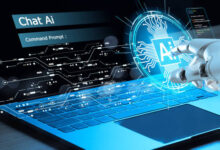How To Develop AI-Powered Chatbots For Customer Support

Just sit down and imagine a world where customer support is always available, always helpful, and always accurate.
A world where customers can get the help they need quickly and easily, without having to wait on hold or talk to multiple people.
This is the world of AI-powered chatbots.
AI-powered chatbots are computer programs that can simulate conversation with humans. They are used in a variety of industries, including customer support.
So in this article, we will look into How to develop AI-powered chatbots for customer support.
Benefits of using AI-powered chatbots for customer support

There are many benefits to using AI-powered chatbots for customer support, including:
- Improved customer satisfaction: AI-powered chatbots can provide 24/7 customer support, which can lead to improved customer satisfaction.
- Reduced costs: AI-powered chatbots can help to reduce customer support costs by automating tasks such as answering frequently asked questions and resolving simple issues.
- Increased efficiency: AI-powered chatbots can help to increase the efficiency of customer support by handling multiple conversations at the same time.
- Improved data collection: AI-powered chatbots can collect data on customer interactions, which can be used to improve products and services.
How to develop AI-powered chatbots for customer support
There are a few key steps involved in developing AI-powered chatbots for customer support:
- Define the scope of the chatbot: What tasks will the chatbot be responsible for? What kind of information will it need to access?
- Collect training data: The chatbot will need to be trained on a large dataset of customer interactions. According to techtarget.com, this data can be collected from customer support transcripts, social media data, and other sources.
- Choose a chatbot development platform: There are a number of chatbot development platforms available, such as Dialogflow, Rasa, and Amazon Lex.
- Develop the chatbot: Using the chatbot development platform, you can create the chatbot’s logic and flow. You will also need to train the chatbot on the training data.
- Test and deploy the chatbot: Once the chatbot is developed, you will need to test it thoroughly to ensure that it is working properly. Once the chatbot is tested, you can deploy it to your customers.
Tips for developing AI-powered chatbots for customer support
Here are a few tips for developing AI-powered chatbots for customer support:
- Keep it simple: The chatbot should be easy to use and understand. Avoid using complex language or jargon.
- Start small: Don’t try to build a chatbot that can do everything. Start by building a chatbot that can handle a few common tasks. You can always add more features later.
- Use a variety of training data: The more training data you use, the better the chatbot will be able to understand and respond to customer queries.
- Test and monitor the chatbot regularly: The chatbot should be tested and monitored regularly to ensure that it is working properly and that it is meeting the needs of your customers.
FAQs about How to develop AI-powered chatbots for customer support
What are the different types of AI-powered chatbots?
There are two main types of AI-powered chatbots: rule-based chatbots and machine learning chatbots.
- Rule-based chatbots: Rule-based chatbots follow a set of predefined rules to respond to customer queries.
- Machine learning chatbots: Machine learning chatbots use machine learning to learn from customer interactions and improve their responses over time.
What are the challenges of developing and deploying AI-powered chatbots?
Some of the challenges of developing and deploying AI-powered chatbots include:
- Cost: Developing and deploying AI-powered chatbots can be expensive, especially for machine learning chatbots.
- Complexity: Developing and deploying AI-powered chatbots can be complex, especially for businesses that do not have experience with AI.
- Data privacy: AI-powered chatbots collect a lot of data on customer interactions. It is important to ensure that this data is collected and used responsibly.
How can I overcome the challenges of developing and deploying AI-powered chatbots?
Here are a few tips for overcoming the challenges of developing and deploying AI-powered chatbots:
- Start small: Don’t try to build a complex chatbot all at once. Start by building a chatbot that can handle a few common tasks. You can always add more features later.
- Use a chatbot development platform: There are a number of chatbot development platforms available, such as Dialogflow, Rasa, and Amazon Lex. These platforms can make it easier to develop and deploy AI-powered chatbots.
- Work with a partner: If you don’t have experience with AI, you may want to work with a partner who can help you to develop and deploy your chatbot.
What are some of the best practices for developing and deploying AI-powered chatbots?
Here are some best practices for developing and deploying AI-powered chatbots:
- Define the scope of the chatbot: What tasks will the chatbot be responsible for? What kind of information will it need to access?
- Collect training data: The chatbot will need to be trained on a large dataset of customer interactions. This data can be collected from customer support transcripts, social media data, and other sources.
- Choose a chatbot development platform: There are a number of chatbot development platforms available, such as Dialogflow, Rasa, and Amazon Lex.
- Develop the chatbot: Using the chatbot development platform, you can create the chatbot’s logic and flow. You will also need to train the chatbot on the training data.
- Test and deploy the chatbot: Once the chatbot is developed, you will need to test it thoroughly to ensure that it is working properly. Once the chatbot is tested, you can deploy it to your customers.
Conclusion
AI-powered chatbots have the potential to revolutionize customer support. By following the tips and best practices above, you can develop and deploy an AI-powered chatbot that will help you to improve customer satisfaction, reduce costs, and increase efficiency.
I believe that AI-powered chatbots have the potential to make the world a better place. By making customer support available to everyone, regardless of their income or location, AI-powered chatbots can help to level the playing field and create a more equitable world.
I encourage businesses of all sizes to consider using AI-powered chatbots to improve their customer support. AI-powered chatbots can help you to provide better customer service, reduce costs, and increase efficiency.
Additional tips
- Don’t be afraid to experiment: AI-powered chatbots are a new technology, so there is no right or wrong way to do it. Experiment with different approaches to find what works best for your business and your customers.
- Get feedback from your customers: Once you have deployed your chatbot, be sure to get feedback from your customers. This feedback will help you to improve your chatbot and make it more useful for your customers.
- Have fun! AI-powered chatbots can be a great way to engage with your customers and provide them with a more personalized experience. So have fun with it!
Thank you for reading, please if you have any question concerning how to develop AI-powered chatbots for customer support, do well to drop it in the comment section below.








